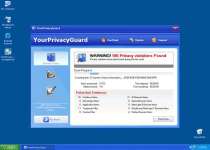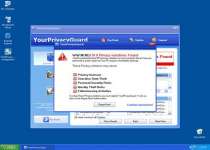YourPrivacyGuard
Posted: January 24, 2008
Threat Metric
The following fields listed on the Threat Meter containing a specific value, are explained in detail below:
Threat Level: The threat level scale goes from 1 to 10 where 10 is the highest level of severity and 1 is the lowest level of severity. Each specific level is relative to the threat's consistent assessed behaviors collected from SpyHunter's risk assessment model.
Detection Count: The collective number of confirmed and suspected cases of a particular malware threat. The detection count is calculated from infected PCs retrieved from diagnostic and scan log reports generated by SpyHunter.
Volume Count: Similar to the detection count, the Volume Count is specifically based on the number of confirmed and suspected threats infecting systems on a daily basis. High volume counts usually represent a popular threat but may or may not have infected a large number of systems. High detection count threats could lay dormant and have a low volume count. Criteria for Volume Count is relative to a daily detection count.
Trend Path: The Trend Path, utilizing an up arrow, down arrow or equal symbol, represents the level of recent movement of a particular threat. Up arrows represent an increase, down arrows represent a decline and the equal symbol represent no change to a threat's recent movement.
% Impact (Last 7 Days): This demonstrates a 7-day period change in the frequency of a malware threat infecting PCs. The percentage impact correlates directly to the current Trend Path to determine a rise or decline in the percentage.
| Threat Level: | 6/10 |
|---|---|
| Infected PCs: | 57 |
| First Seen: | July 24, 2009 |
|---|---|
| OS(es) Affected: | Windows |
 YourPrivacyGuard is a rogue anti-spyware application that is usually downloaded and installed onto your computer by a Trojan finding its way through exploits in the Windows Operating system. Once installed YourPrivacyGuard will generate false notifications of non-existent threats and irritating pop-ups even if you have a popup blocker on your computer. Such actions will consume your machine's processing power and thus will slow down your system or even cause its instability. YourPrivacyGuard's main goal is to trick you into buying a full version, which is fake, therefore it is strongly advised to remove this malware without any hesitation.
YourPrivacyGuard is a rogue anti-spyware application that is usually downloaded and installed onto your computer by a Trojan finding its way through exploits in the Windows Operating system. Once installed YourPrivacyGuard will generate false notifications of non-existent threats and irritating pop-ups even if you have a popup blocker on your computer. Such actions will consume your machine's processing power and thus will slow down your system or even cause its instability. YourPrivacyGuard's main goal is to trick you into buying a full version, which is fake, therefore it is strongly advised to remove this malware without any hesitation.
Technical Details
File System Modifications
Tutorials: If you wish to learn how to remove malware components manually, you can read the tutorials on how to find malware, kill unwanted processes, remove malicious DLLs and delete other harmful files. Always be sure to back up your PC before making any changes.
The following files were created in the system:stpHlpr.dll
File name: stpHlpr.dllSize: 53.24 KB (53248 bytes)
MD5: a13f3ccda0750a25dc4e594bc9eb889c
Detection count: 73
File type: Dynamic link library
Mime Type: unknown/dll
Group: Malware file
Last Updated: December 11, 2009
GDC.exe
File name: GDC.exeSize: 1.82 MB (1825280 bytes)
MD5: 949b22a85f6379628f13bb0c1ae70222
Detection count: 55
File type: Executable File
Mime Type: unknown/exe
Group: Malware file
Last Updated: December 11, 2009
GDCPatch.exe
File name: GDCPatch.exeSize: 736.94 KB (736949 bytes)
MD5: 8d7c4185441483831212d249376f3f21
Detection count: 45
File type: Executable File
Mime Type: unknown/exe
Group: Malware file
Last Updated: December 11, 2009

Leave a Reply
Please note that we are not able to assist with billing and support issues regarding SpyHunter or other products. If you're having issues with SpyHunter, please get in touch with SpyHunter customer support through your SpyHunter . If you have SpyHunter billing questions, we recommend you check the Billing FAQ. For general suggestions or feedback, contact us.